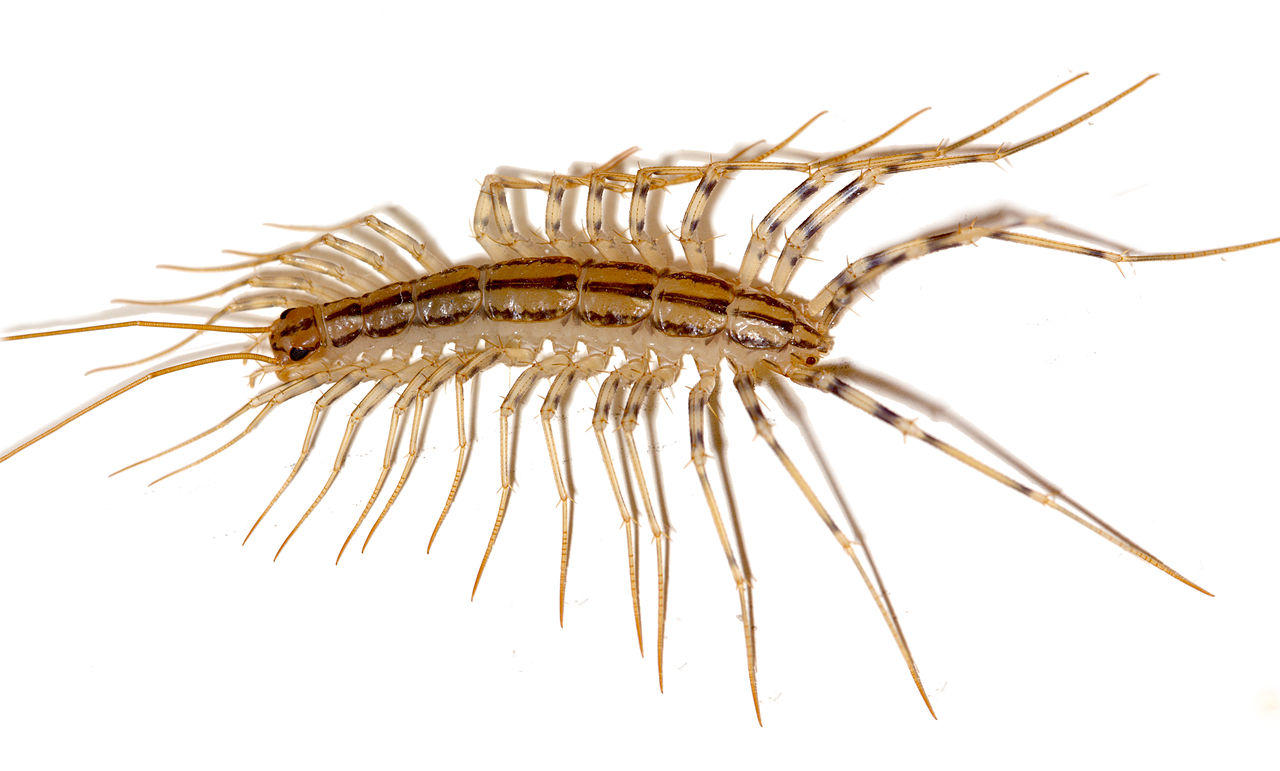House Centipedes
 The
body of an adult
Scutigera coleoptrata is 25 to 35 mm (0.98 to
1.38 in) in length. Up to 15 pairs of long legs are
attached to the rigid body. Together with the
antennae they give the centipede an appearance of
being 75 to 100 mm (3 to 4 in) in length. The
delicate legs enable it to reach surprising speeds
of up to 0.4 meters per second (1.3 ft/s) running
across floors, up walls and along ceilings. Its body
is yellowish-grey and has three dark dorsal stripes
running down its length; the legs also have dark
stripes.
S. coleoptrata has developed automimicry in that
its tail-like hind legs present the appearance of
antennae. When the centipede is at rest, it is not
easy to tell its front from its back. Unlike most
other centipedes, house centipedes and their close
relatives have well-developed faceted eyes.
The
body of an adult
Scutigera coleoptrata is 25 to 35 mm (0.98 to
1.38 in) in length. Up to 15 pairs of long legs are
attached to the rigid body. Together with the
antennae they give the centipede an appearance of
being 75 to 100 mm (3 to 4 in) in length. The
delicate legs enable it to reach surprising speeds
of up to 0.4 meters per second (1.3 ft/s) running
across floors, up walls and along ceilings. Its body
is yellowish-grey and has three dark dorsal stripes
running down its length; the legs also have dark
stripes.
S. coleoptrata has developed automimicry in that
its tail-like hind legs present the appearance of
antennae. When the centipede is at rest, it is not
easy to tell its front from its back. Unlike most
other centipedes, house centipedes and their close
relatives have well-developed faceted eyes.
Reproduction and development
House centipedes lay their eggs
in spring. In a laboratory observation of 24 house
centipedes, an average of 63 and a maximum of 151
eggs were laid. As with many other arthropods, the
larvae look like miniature versions of the adult,
albeit with fewer legs. Young centipedes have four
pairs of legs when they are hatched. They gain a new
pair with the first molting, and two pairs with each
of their five subsequent moltings. Adults with 15
pairs of legs retain that number through three more
molting stages (sequence 4-5-7-9-11-13-15-15-15-15
pairs). House centipedes live anywhere from three to
seven years, depending on the environment. They can
start breeding in their third year. To begin mating,
the male and female circle around each other. They
initiate contact with their antennae. The male
deposits his sperm on the ground and the female then
uses it to fertilize her eggs.
Behavior and ecology
House centipedes feed on spiders,
bed bugs, termites, cockroaches, silverfish, ants,
and other household arthropods. They administer
venom through forcipules. These are not part of
their mandibles, so strictly speaking they sting
rather than bite. They are mostly nocturnal hunters.
Despite their developed eyes, they seem to rely
mostly on their antennae when hunting. Their
antennae are sensitive to both smells and tactile
information. They use both their mandibles and their
legs for holding prey. This way they can deal with
several small insects at the same time. To capture
prey they either jump onto it or use their legs in a
technique described as "lassoing".
Habitat
Outdoors, house centipedes prefer to live in cool,
damp places. Centipede respiratory systems do not
provide any mechanism for shutting the spiracles,
and that is why they need an environment that
protects them from dehydration and excessive cold.
Most live outside, primarily under large rocks,
piles of wood, and especially in compost piles.
Within the home, these centipedes are found in
almost any part of the house. Most commonly they are
encountered in basements, bathrooms, and lavatories,
which tend to be humid, but they can also be found
in drier places like offices, bedrooms and dining
rooms. The greatest likelihood of encountering them
is in spring, when they come out because the weather
gets warmer, and in autumn/fall, when the cooling
weather forces them to find shelter in human
habitats.The
Indian meal moth, a common house-infesting moth,
often is confused with the clothes moth. However, it
does not attack clothing but rather is associated
with dried food. Indian meal moth adults are darker
on one half of the body.
